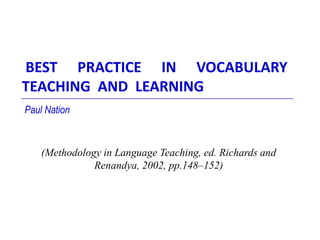
BEST PRACTICE IN VOCABULARY TEACHING AND LEARNING
- 1. BEST PRACTICE IN VOCABULARY TEACHING AND LEARNING Paul Nation (Methodology in Language Teaching, ed. Richards and Renandya, 2002, pp.148–152)
- 2. VOCABULARY AND MEANINGFOCUSED INPUT Reading has long been seen as a major source of vocabulary growth. • For several reasons. Research indicates that there is a fragility to this kind of learning. Firstly : Research with native speakers of English shows that the amount of vocabulary learning that occurs during the reading of a text is rather small. • This means that there is a close relationship between vocabulary growth and the amount and variety of meaning-focused instruction. • It is necessary to use vocabulary knowledge to show any learning at all.
- 3. VOCABULARY AND MEANINGFOCUSED INPUT Frequency: • There is a very rapid drop-off in frequency of vocabulary after the most frequent 2.000 to 3.000 words of the language. • Beyond the most frequent words, considerable meaningfocused input is needed for vocabulary growth to continue at a reasonable pace.
- 4. VOCABULARY AND MEANINGFOCUSED INPUT Secondly: Why vocabulary learning through meaning-focused input is fragile is that it depends heavily on the quality of the learners’ control of the reading skill. • One of the major barriers to reading in the second language is vocabulary size. Thirdly : Why vocabulary learning through meaning-focused input is fragile is that the type of reading that is done will strongly influence vocabulary learning. Familiar areas ---------- easily cope up with new words , not learn them Unfamiliar areas -------- a greater chance to learn new vocabulary ----- to get meaning.
- 5. VOCABULARY AND MEANINGFOCUSED INPUT • It is valuable to give attention to language as a system and not just as messages. • Giving attention to language items as a part of the language system (language-focused instruction) makes learning more certain. • Relying on meaning-focused input alone is leaving too much to chance. • The best practice in teaching vocabulary and learning should aim to provide large quantities of suitable graded input, by providing it across a range of genres and topics, and by providing language-focused activities to support it.
- 6. VOCABULARY AND MEANINGFOCUSED OUTPUT Meaning-focused speaking and writing are way of expanding learners’ vocabulary. Researches have concluded that : • The written input to a communicative task has a major effect on what vocabulary is used and negotiated during the task. • Negotiation of the meaning of the unknown vocabulary meant that words had a greater chance of being learned. • The quality of learning depends on the quality of use of the previously unknown vocabulary during the communicative task. The more the vocabulary is used, the better it is learned.
- 7. VOCABULARY AND MEANINGFOCUSED OUTPUT • Learners are able to provide useful information to each other on most of the vocabulary in a typical communicative task. • Learners who negotiate the meaning do not seem to learn more that learners who observe the negotiation. • Only a small amount of the negotiation in a communicative task is negotiation of word meaning.
- 8. DEVELOPING FLUENCY WITH VOCABULARY • Fluency means making the best of what you already know. It involves some kind of repetition so that speed and smoothness of delivery can improve. • The effect of fluency on vocabulary knowledge is still largely an explored area. • There are some vocabulary items that need to be learned to a very high degree of fluency as quickly as possible. These include numbers, polite formulas, items for controlling language use ( e.g. to ask someone to repeat, speak more slowly, and so on), times, period and quantities. 3 points workable for fluency : • Students work with the well known language items and familiar ideas. • Learners focus on message • Use of repetition.
- 9. VOCABULARY AND LANGAUGE-FOCUSED INSTRUCTION Language-focused instruction occurs when learners direct their attention to language items not for producing or comprehending a particular message, but for gaining knowledge about the item as a part of the language system. Language-focused instruction thus includes focusing on the pronunciation and spelling of words, learning the meaning of words, memorizing collocations, phrases and sentences containing a word.
- 10. KINDS OF LANGUAGE-FOCUSED VOCABULARY INSTRUCTION 1- Guessing unknown words from context • Guessing from context focuses on the particular reference of a word as determined by the context rather than its underlying meaning. 2- Learning the meanings of unknown words • The assumption that all vocabulary learning should be in context is not supported by research and what successful learners do. Research shows that :
- 11. KINDS OF LANGUAGE-FOCUSED VOCABULARY INSTRUCTION • Explicit, decontextualized study of vocabulary is an effective way of rapidly increasing vocabulary size. • Learning achieved in this way can last for a very long time. • There are many ways that increase the efficiency of languagefocused learning such as mnemonic techniques and vocabulary cards which encourage retrieval and organization of learning.
- 12. KINDS OF LANGUAGE-FOCUSED VOCABULARY INSTRUCTION 3 – Study of word parts and mnemonic devices Word parts such prefixes and suffixes occur in many words. Knowledge of these word parts can be used to improve the learning of many words through relating unknown word forms and meanings to known word parts. Mnemonic devices - ---------. Roy G. Biv